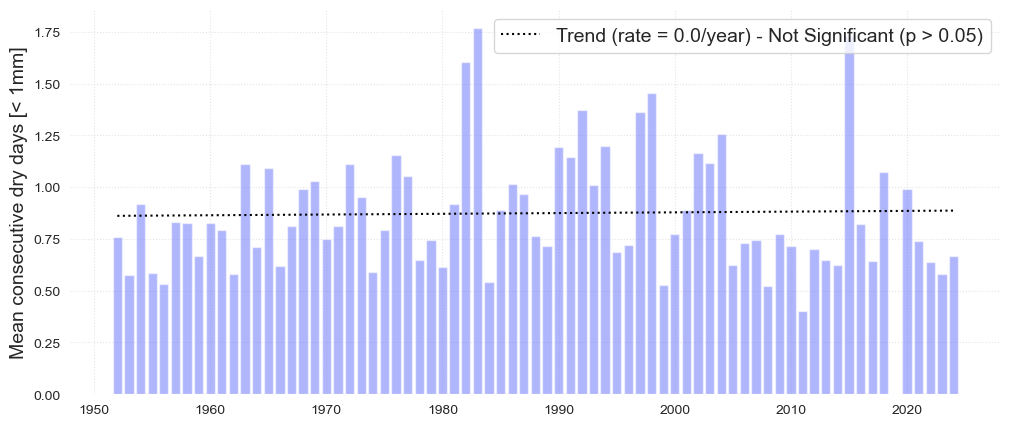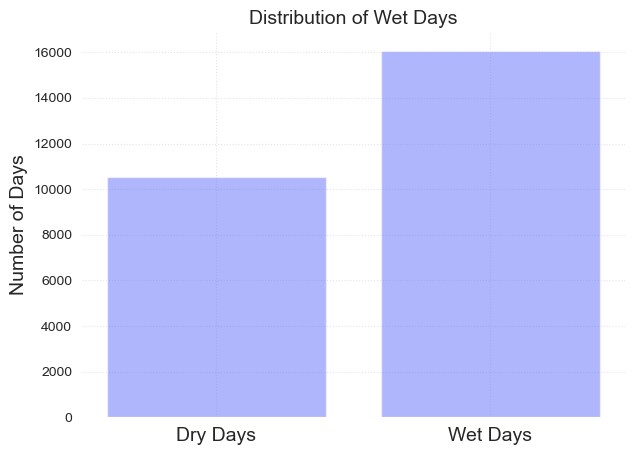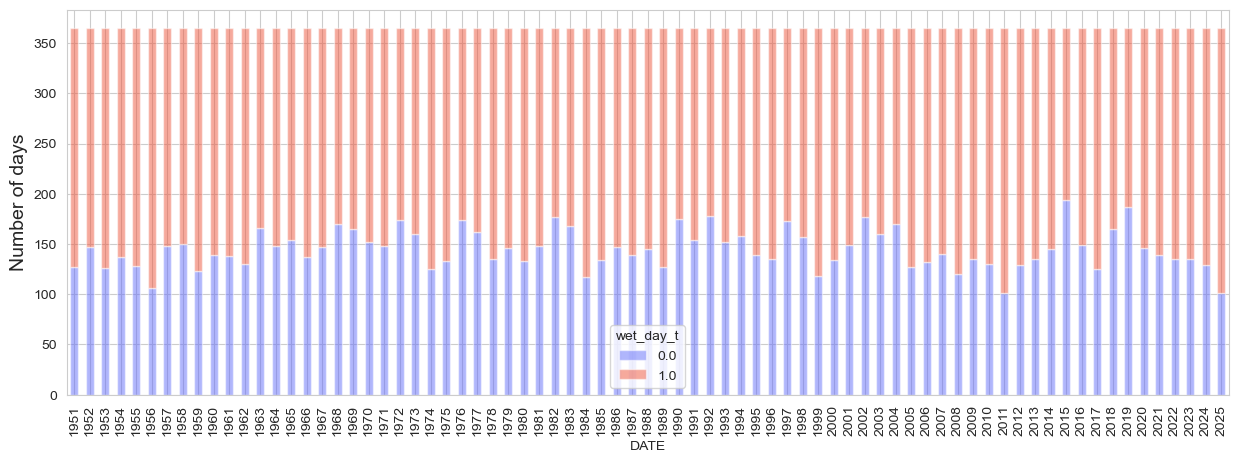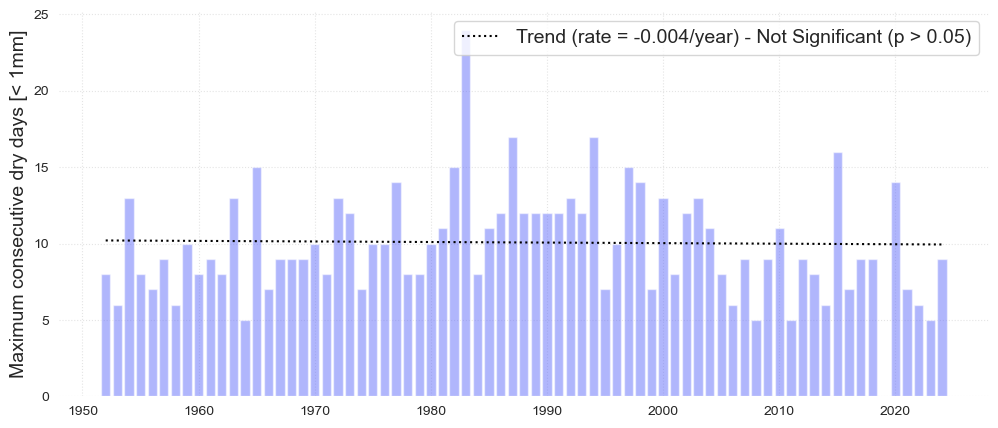Dry Conditions#

Setup#
First, we need to import all the necessary libraries. Some of them are specifically developed to handle the download and plotting of the data and are hosted at the indicators set-up repository in GitHub
Show code cell source
import os
import os.path as op
import sys
import folium
import numpy as np
import pandas as pd
import matplotlib.pyplot as plt
from myst_nb import glue
sys.path.append("../../../../indicators_setup")
from ind_setup.plotting_int import plot_timeseries_interactive
from ind_setup.plotting import plot_bar_probs
from ind_setup.colors import get_df_col
from ind_setup.core import fontsize
from ind_setup.tables import plot_df_table, table_rain_dry_summary
sys.path.append("../../../functions")
from data_downloaders import GHCN
from rain_func import consecutive_dry_days, count_consecutive_days
country = 'Palau'
vars_interest = ['PRCP']
Get Data#
update_data = False
path_data = "../../../data"
path_figs = "../../../matrix_cc/figures"
Show code cell source
if update_data:
df_country = GHCN.get_country_code(country)
print(f'The GHCN code for {country} is {df_country["Code"].values[0]}')
df_stations = GHCN.download_stations_info()
df_country_stations = df_stations[df_stations['ID'].str.startswith(df_country.Code.values[0])]
print(f'There are {df_country_stations.shape[0]} stations in {country}')
Observations from Koror Station#
https://www.ncei.noaa.gov/data/global-historical-climatology-network-daily/doc/GHCND_documentation.pdf
The data used for this analysis comes from the GHCN (Global Historical Climatology Network)-Daily database.
This a database that addresses the critical need for historical daily temperature, precipitation, and snow records over global land areas. GHCN-Daily is a
composite of climate records from numerous sources that were merged and then subjected to a suite of
quality assurance reviews. The archive includes over 40 meteorological elements including temperature daily maximum/minimum, temperature at observation time,
precipitation and more.
Show code cell source
if update_data:
GHCND_dir = 'https://www.ncei.noaa.gov/data/global-historical-climatology-network-daily/access/'
id = 'PSW00040309' # Koror Station
dict_prcp = GHCN.extract_dict_data_var(GHCND_dir, 'PRCP', df_country_stations.loc[df_country_stations['ID'] == id])[0]
data = dict_prcp[0]['data']#.dropna()
data.to_pickle(op.join(path_data, 'GHCN_precipitation.pkl'))
else:
data = pd.read_pickle(op.join(path_data, 'GHCN_precipitation.pkl'))
data['wet_day'] = np.where(data['PRCP'] > 1, 1, np.where((np.isnan(data['PRCP'])==True), np.nan, 0))
fig, ax = plot_bar_probs(x = [0, 1], y = data.groupby('wet_day').count()['PRCP'].values, labels = ['Dry Days', 'Wet Days'])
ax.set_title('Distribution of Wet Days', fontsize = fontsize)
ax.set_ylabel('Number of Days', fontsize = fontsize)
Text(0, 0.5, 'Number of Days')

Analysis#
Number of days over and above 1mm threshold#
The following plot analyzes the number of wet (over 1mm) and dry days over time
Dry days are considered those in which precipitation is lower than 1mm.
threshold = 1 #np.percentile(data['PRCP'].dropna(), 90)
data['wet_day_t'] = np.where(data['PRCP'] > threshold, 1, np.where((np.isnan(data['PRCP'])==True), np.nan, 0))
data_th = data.groupby([data.index.year, data.wet_day_t]).count()['PRCP']
data_th = data_th/data.groupby(data.index.year).count()['PRCP'] * 365
Plotting#
fig, ax = plt.subplots(figsize = [15, 5])
data_th.unstack().plot(kind = 'bar', stacked = True, ax = ax, color = get_df_col()[:2], edgecolor = 'white', alpha = .5)
ax.set_ylabel('Number of days', fontsize = fontsize)
Text(0, 0.5, 'Number of days')

The following plots analyze independently the number of wet and dry days over time as well the trend over time which is not significant in both cases.
#Wet days
data2 = data.loc[data['wet_day_t'] == 1]
data2 = data2.groupby(data2.index.year).count()
fig, ax, trend = plot_bar_probs(x = data2.index, y = data2.PRCP.values, trendline = True,
y_label = 'Number of wet days [>1mm]', figsize = [15, 4], return_trend = True)
plt.savefig(op.join(path_figs, 'F7a_Wet_days_1mm.png'), dpi=300, bbox_inches='tight')
glue("trend_wet", float(trend), display=False)

#Dry days
data2 = data.loc[data['wet_day_t'] == 0]
data2 = data2.groupby(data2.index.year).count()
fig, ax, trend = plot_bar_probs(x = data2.index, y = data2.PRCP.values, trendline = True,
y_label = 'Number of dry days [<1mm]', figsize = [15, 4], return_trend = True)
plt.savefig(op.join(path_figs, 'F6a_Number_dry.png'), dpi=300, bbox_inches='tight')
glue('trend_dry', float(trend), display=False)

data = data.groupby(data.index.year).filter(lambda x: len(x) >= 300).dropna()
data['dry_day'] = np.where(data['PRCP'] < threshold, 1, 0)
consecutive_dry_year = data.groupby(data.index.year)['dry_day'].apply(consecutive_dry_days)
data['below_threshold'] = data['PRCP'] < threshold
data['consecutive_days'] = count_consecutive_days(data['below_threshold'])
Number of consecutive dry days#
The following plot represents the average number of consecutive dry days which are considered those in which precipitation is lower than 1mm.
fig, ax = plot_bar_probs(np.unique(data.index.year), data.groupby(data.index.year)['consecutive_days'].mean(),
trendline =True, y_label = 'Mean consecutive dry days [< 1mm]',
figsize = [12, 5])
glue("mean_dry_days_fig", fig, display=False)

The following plot represents the maximum number of dry days which are considered those in which precipitation is lower than 1mm.
fig = plot_bar_probs(np.unique(data.index.year), data.groupby(data.index.year)['consecutive_days'].max(),
trendline =True, y_label = 'Maximum consecutive dry days [< 1mm]',
figsize = [12, 5])
plt.savefig(op.join(path_figs, 'F6b_Consecutive_dry.png'), dpi=300, bbox_inches='tight')

Table#
Table sumarizing different metrics of the data analyzed in the plots above
df = table_rain_dry_summary(data)
fig = plot_df_table(df.T, figsize = (600, 150),)

